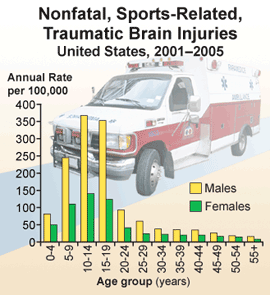Other Features
Featured Data & Statistics

Nonfatal Traumatic Brain Injuries (TBIs)
Injuries from Sports and Recreation Activities --- United States, 2001—2005
Each year in the United States, an estimated 38 million children and adolescents participate in organized sports (1), and approximately 170 million adults participate in some type of physical activity not related to work (2). The health benefits of these activities are tempered by the risk for injury, including traumatic brain injury (TBI). CDC estimates that 1.1 million persons with TBIs are treated and released from U.S. hospital emergency departments (EDs) each year, and an additional 235,000 are hospitalized for these injuries (3). TBIs can result in long-term, negative health effects (e.g., memory loss and behavioral changes) (3). To characterize sports- and recreation-related (SR-related) TBIs among patients treated in U.S. hospital EDs, CDC analyzed data from the National Electronic Injury Surveillance System--All Injury Program (NEISS-AIP) for the period 2001--2005. This report summarizes the results of that analysis, which indicated that an estimated 207,830 patients with nonfatal SR-related TBIs were treated in EDs each year during this period. The highest rates of SR-related TBI ED visits for both males and females occurred among those aged 10--14 years. Increased awareness of TBI risks, prevention strategies, and the importance of timely identification and management is essential for reducing the incidence, severity, and long-term negative health effects of this type of injury.
During 2001--2005, an estimated 207,830 patients with SR-related TBIs were treated in U.S. hospital EDs each year, accounting for 5.1% of all SR-related ED visits. Overall, males accounted for approximately 70.5% of SR-related TBI ED visits. The highest rates of SR-related TBI ED visits for both males and females occurred among those aged 10--14 years, followed by those aged 15--19 years. Activities associated with the greatest number of TBI-related ED visits included bicycling, football, playground activities, basketball, and riding all-terrain vehicles (ATVs). Activities for which TBI accounted for greater than 7.5% of ED visits for that activity included horseback riding (11.7%), ice skating (10.4%), riding ATVs (8.4%), tobogganing/sledding (8.3%), and bicycling (7.7%). Each year, an estimated 21,311 SR-related TBI ED visits occurred that involved patients who were either subsequently hospitalized or transferred to another facility for additional care. Approximately 10.3% of patients with SR-related TBIs were hospitalized or transferred, compared with 3.1% of patients with SR-related injuries overall. Activities associated with the greatest proportion of TBI-related ED visits requiring either hospitalization or transfer included riding ATVs (30.2%), riding mopeds/minibikes/dirt bikes (21.9%), bicycling (15.6%), golfing (13.6%), and riding scooters (10.5%).
During 2001--2005, children aged 5--18 years accounted for an estimated 2.4 million (59.7%) SR-related ED visits, of which approximately 134,959 (5.6%) were categorized as TBI-related. Approximately 17.9% of SR-related hospitalizations in this age group were attributed to TBIs. Activities associated with the greatest number of TBI-related ED visits in this age group included bicycling, football, basketball, playground activities, and soccer. For all ages, activities for which TBI accounted for the greatest proportion of ED visits for that activity and the activities associated with the greatest number of TBI-related ED visits resulting in hospitalization were similar.
References:
1. National Council on Youth Sports. Report on trends and participation in youth sports. Stuart, FL: National Council on Youth Sports; 2001. Available at http://www.ncys.org/pdf/marketresearch.pdf.
2. CDC. 2006 Behavioral Risk Factor Surveillance System. Available at http://apps.nccd.cdc.gov/brfss/display.asp?cat=ex&yr=2006&qkey=4347&state=ub.
3. Langlois JA, Rutland-Brown W, Wald MM. The epidemiology and impact of traumatic brain injury. J Head Trauma Rehabil 2006;21: 375--8.
Source:
Centers for Disease Control and Prevention. Nonfatal Traumatic Brain Injuries from Sports and Recreation Activities --- United States, 2001—2005. MMWR 2007; 56(29);733-737.
For More Information:
CDC’s Traumatic Brain Injury site
CDC Feature: Heads Up – Concussion in Youth Sports
Tool Kit on Concussion for High School Coaches
TBI Fact Sheets
 |
Heads Up! |
 |
Heads Up! |
 |
Heads Up! Play it Safe When it Comes to Concussions ¡Atención! Tenga precaución con alguien que haya sufrido una concusión |
 |
Heads Up! Concussion Information for Physicians |
Page last reviewed: March 13, 2008
Page last updated: March 13, 2008
Content source: National Center for Injury Prevention and Control
Content owner: National Center for Health Marketing
URL for this page: http://www.cdc.gov/datastatistics/2008/brainInjuries/
